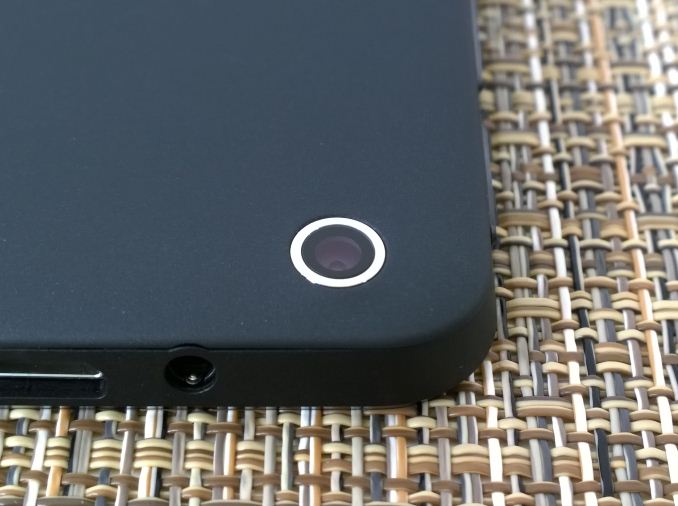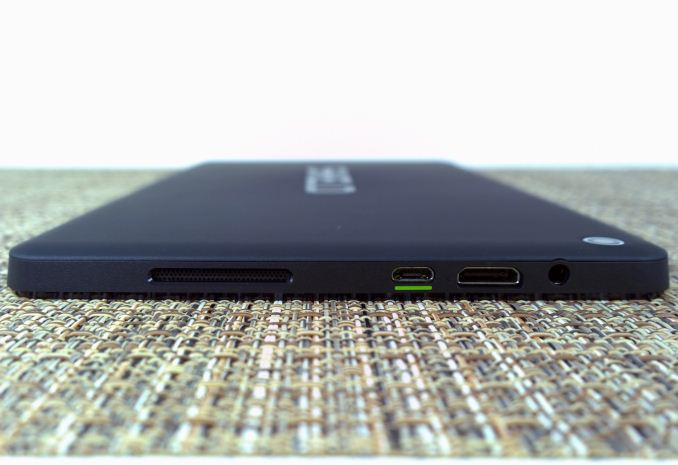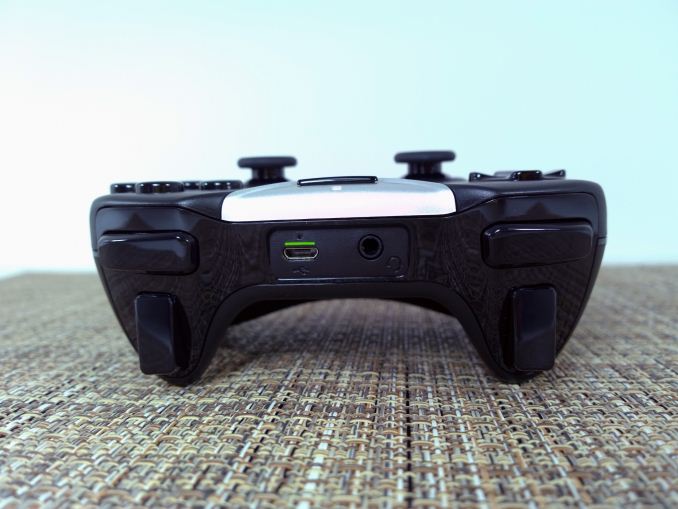The NVIDIA SHIELD Tablet Review
by Joshua Ho on July 29, 2014 9:00 AM ESTFinal Words
If I’m honest, it’s hard for me to review tablets. While I academically understand why people like tablets, I’ve never really found a use for them. They’re less comfortable to use in bed than a phone, I usually can’t type on a tablet as quickly as I do on a phone due to the size and weight, and in general it’s hard to justify a tablet when a phone is generally much more versatile. So when I got the Shield Tablet, I didn’t really know what to expect. While I have a Shield Portable, I don’t spend much time gaming on it, especially when I have a desktop that can do it much better. I came away from my experience pleasantly surprised.
Over the past five days, I’ve learned a lot about this device. As a tablet, it’s good. The material design and industrial design is acceptable and the device itself is quite ergonomic but it doesn’t blow me away. However, given the need to meet cost constraints, the matte plastic feel is really all that’s necessary and I don’t have any complaints in this area.
In the other fundamentals, we see a bit of a checkered pattern. In the display, the static contrast is quite high, and the calibration is good, but the gamut of the display doesn’t cover sRGB. This would definitely be an area that should be improved for the next generation. Although there are some compelling reasons to go with smaller color gamut, it ends up as a disadvantage when compared to other general-purpose tablets. The display is still perfectly usable, but it's a bit more washed out than I'd like.
In battery life, we see that the Shield Tablet ends up doing relatively well in web browsing, but for intensive gaming the tablet can’t spend much time away from an outlet before draining the battery completely. This is likely to be an unavoidable tradeoff, given the immense amounts of performance that Tegra K1 provides versus the power costs of doing so on a 28nm process. Anyone that has lived with a gaming laptop should understand this. As said before, it’s also possible to improve battery life from the 2.5 hour figure if the game is light enough to allow the GPU to run at lower frequencies. Barring that, NVIDIA has included options to cap the maximum frame rate of the display and reduce maximum CPU frequencies.
Otherwise the only other notable difficulty I’ve run into is with the stylus. Generally speaking it works well enough, but the stylus requires a bit more lift between words than I’m used to and keeping it from feeling fully natural. But I will be the first to admit that this is a minor issue at best.
Outside of the tablet itself, the gaming features are compelling. The larger 8” display and massively improved SoC on the Shield Tablet made for a far better gaming experience than what I had on Shield Portable. There’s a great deal of potential in ShadowPlay on a tablet, as while screen recording is nothing new in PCs this feature is often difficult to enable on Android. This is before we talk about the effects that live video encoding has on UI performance. ShadowPlay has managed to enable easy screen recording on a mobile device and do so without significantly impacting performance.
Meanwhile GameStream and GRID are even better on the larger screen that the tablet provides. While it was cool to play PC games on the Shield Portable, the size of the display simply made some elements too small to reasonably see. Now, there are no such issues. GameStream and GRID are definitely a lot of fun to use, especially if the game is well-adapted to playing on a controller.
Ultimately though, I feel that the native game library is the most important aspect of this device. While there are plenty of solid single player games, multiplayer games are few and far between. I still feel that multiplayer is where Shield has the strongest potential because it makes the difference between tens of hours per game and hundreds, even thousands of hours per game. There are definitely signs that this aspect of the ecosystem will improve in the near future as Trine 2 supports local multiplayer and War Thunder on Shield Tablet should be able to play online against console and PC players.
After getting through all of these observations over the past five days, I’ve come to realize that even though it’s not the perfect tablet, all of the features that this device brings to the table right now would be enough for me to seriously consider buying one. If NVIDIA manages to get enough multiplayer titles with an active community on Shield Tablet, there wouldn’t be a need to stop and consider at all. As someone that has spent the past few years never considering a tablet purchase at all, the Shield Tablet is the first ARM tablet that I would seriously think about buying.
The SHIELD Tablet is 299 USD for the 16GB WiFi model, 399 USD for the 32 GB LTE model. Each controller is 59.99 USD and the cover is 39.99 USD. While the 16GB model is 70 dollars more expensive than the Nexus 7 equivalent, the gap narrows to 50 dollars for the 32GB LTE model. Given the sheer amount of utility that this device brings to the table, the pricing is definitely set at the right place.














174 Comments
View All Comments
Stuka87 - Tuesday, July 29, 2014 - link
I think the tablet on its own is decent. Although it is very heavy for its size (Which BTW this review does not mention its weight anywhere).The controller is what I end up scratching my head over. In their release photos they show a girl gaming with the tablet, but sitting like 3ft away. As if being that far away would be enjoyable.
One other thing that is not clear, if the tablet is NOT on wifi, will the controller still work? The article makes it sound like you have to be on wifi.
Friendly0Fire - Tuesday, July 29, 2014 - link
WiFi *Direct* is a straight connection between the tablet and the controller using the WiFI protocol. It most certainly doesn't need a network to work.Stuka87 - Tuesday, July 29, 2014 - link
Hm, ok. But he specifically said it depends what type of wifi network you are on.lmcd - Tuesday, July 29, 2014 - link
That's for the connection band. Meaning that if one of the two Wi-Fi bands is in use for Wi-Fi, then the other one is the one that'll be used for the Wi-Fi direct.halca - Tuesday, July 29, 2014 - link
Really? That's it for the directstylus review section? I'm disappointed. I hoped to see more comparison between the old and new, and compared to wacom's tech on samsung note line.scbundy - Tuesday, July 29, 2014 - link
Shame about the screen, but with my old Nexus 7 broken and me looking for a gaming tablet replacement, this one appears to fit the bill perfectly. Especially since my gaming PC has a 780 GTX. Can't wait to try it out.dabotsonline - Tuesday, July 29, 2014 - link
"In essence, this device is already ready to serve as an Android TV device."I thought that Google are mandating a very specific UI design for Android TV devices - one which is very different from this? Do you have any inside info regarding the final version this fall / autumn, Josh?
aamir147 - Tuesday, July 29, 2014 - link
I think he means nvidia can eventually add an android TV mode when connecting via hdmi just like you can get a console mode.SpartyOn - Tuesday, July 29, 2014 - link
Personally, I love my Shield Portable (or whatever they're calling the 1st Gen device). Sitting in bed or on the couch streaming the game I just turned off at my desk is fantastic. It's also the best Android emulator device out there.The recent updates to allow outside the home streaming (which this article incorrectly states as only allowing in-home; please change) and 1080p Console Mode streaming via wired Ethernet, have made this a killer mobile gaming device. Instead of carting my mITX build back and forth when I want to play a game via controller on my HDTV, I can now simply hook up the Shield and stream the game, in full 1080p, to the TV and can hook up an XBOX 360 wireless controller with USB OTG. No more hauling a computer around the house or having to settle for a laptop! Seriously awesome.
My wife and I continuously fight to use the Shield when heading to bed, she for her emulators and me for streaming from my gaming rig. I REALLY want to pick up another one so that she can have her own, so I was hoping this was going to be a self-contained device like the 1st Gen, just with the K1 and maybe some weight balancing, an extra miniUSB port, and a 6" screen with less bezel (the bezel with the 5" is HUGE and I'm sure they could creatively get a slightly bigger screen in there).
Unfortunately, the new Shield device as a tablet is... underwhelming. Sure it has snazzy bells n' whistles for a tablet, but with the larger form factor and lack of handholding ease, this really kills a lot of its portability. I prefer the fully contained controller/screen of the original; plus, it was different and really created a new market. Now it's just another tablet in a crowded field. Seems like a dumb strategy to me.
Until they release a refreshed Shield Portable with the K1, I'll be keeping my money. Kudos to NVIDIA though for the 1st Gen device - I love it.
fivefeet8 - Tuesday, July 29, 2014 - link
Unfortunately, you're probably in the minority at this point and I do understand why some would prefer it that way. One of the reasons I didn't get the original shield is because you couldn't do much else with it besides gaming. Even though I loved the hardware and software, I wanted something that could encompass more. Something I could use for both work and play on mobile. The new Shield Tablet fits that almost perfectly.